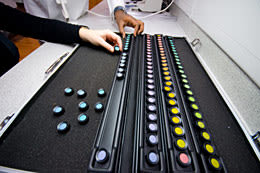The word “color blindness,” which is widely used in everyday life is mostly knows as someone who cant see colours completely. So, what is colourblind? We haven’t come across any person who is fully color blind to our best knowledge, i.e. he/she can only appreciate anything in life as in black and white colour.
In Malaysia, there was a study conducted among 1214 primary school children and the prevalence of colour vision deficiency shows 2.6 percent; (male 4.8% and female 0.2%) from the total amount of tested children. In general, color blindness of different kinds affects approximately 8% of males and less than 1% of females. Red-green deficiency (protanopia-deuteranopia) is the most common type of defective colour vision; occasionally blues (tritanopia) and complete colour blindness is quite rare.
Almost all “color blind” persons can see colors but may have trouble distinguishing between those colors. Not all persons who are color blind have issues with the same colors; most can not differentiate between reds and greens; others can not distinguish between blues and yellows; and a very small number has a disorder called monochromatism that only allows them to see black and white. At this stage, they are known as severely impact colour blind person. Are you a person who are leaving with this disease, yet you are not sure how does it occur and what to do? Lets continue to read more here and find out some new info about what is colourblind!
As we know, the retina is a thin film of tissue covering the inside of the back of the eye. There are two cell types in the retina, that can sense light which is called rods and cones. Rods sense light and dark only, and are very sensitive to low levels of light. Cone cells sense color in the middle of our vision and it is focused too. There are three kinds of colour-sensitive cones: red, green and blue. To assess our color perception, the brain utilizes feedback from these cone cells.
When one or more of the color cone cells are missing, or has lack in its function, or detect a different color than normal, color blindness may occur. When all three cone cells are missing, extreme color blindness occurs. Mild color blindness occurs when all three cone cells are present, but it does not function properly with one cone cell. A different color than normal is observed. Perhaps, moderate and severe colour vision deficiencies occurs when there are more dysfunction observed in normal colour perception. There will be a huge difference found in colour hue and saturation than the normal one or it many just appear as black, white or grey in colour. So, now you may have some idea what is colourblind means.
There are plenty of colour vision testing tools available in market. But most of the time, Ishirara Plate is the common colour vision test that will be used to screen a person with colour vision dysfunction. In advance, Farnsworth D15, Farnsworth 100 Hue, City University Test and many more other colour vision tests will be used. To confirm what colourblind does a person has, it is always best to assess their colour vision dysfunction using multiple testing tools to get it right with consistency and accuracy of a result.

Ishihara Plate 
Farnsworth 100 Hue 
City University Test
It is rare to have the most extreme type of color blindness, where everything is seen in shades of gray. Typically, color blindness affects both eyes equally and becomes stable across the time. Letting us know your history of eye problem or colour blindness; which could be either inherited or acquired, would help us to discover more and help you out with your current visual status. Some of us may even not aware if we have a perfect colour vision functions. Getting your eyes screen for colour vision or any other eyes related issues may help you to overcome from various eyes related diseases earlier! Always remember Prevention is better than Cure!.







